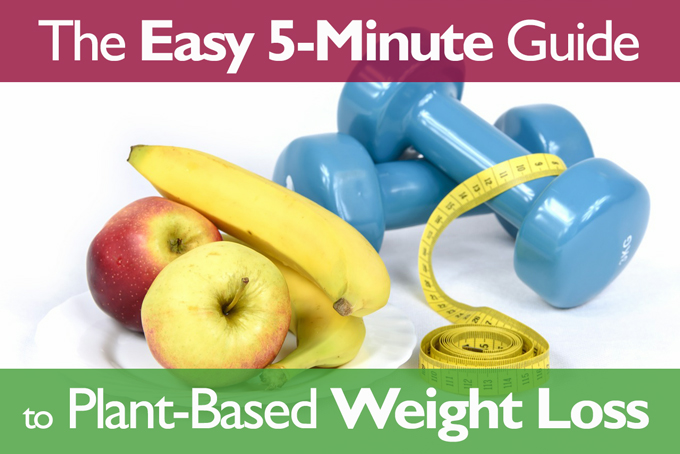
Whether you want to lose 5 pounds or 50 pounds, eating plant-based is the easiest way to do it. You can eat as much as you want and still lose weight! Better yet, when you eat plant-based, you don’t even have to exercise to see results.1 (Although exercise will help you feel your best.)
In fact, in 2015, Harvard researchers and scientists in Taiwan examined 12 different “gold-standard” nutrition studies. Compared to omnivores, those assigned to vegetarian diets (including milk and eggs) lost 3.3 extra pounds, and those assigned to purely plant-based (vegan) diets lost 5.5 extra pounds.2
The icing on the plant-based cake? Not only will you lose weight easily, you’ll be flooding your body with vitamins, minerals, and phytochemicals. That means more energy for working out, chasing after the kids, and avoiding that post-lunch crash. Down the road, being plant-based makes you less likely to get diabetes, certain cancers, and heart disease.3,4
What’s more, a plant-based diet is easy to follow. Of course there are times it will be challenging, but you don’t have to be perfect to see results. (Trust me on this, lol!) Actually, don’t trust me. Try a plant-based diet for yourself for a few weeks. See how you feel—and what happens to the numbers on your scale. 🙂
What does “plant-based” mean?
Plant-based simply means centering your diet on whole plant foods. That includes minimizing or avoiding animal products like meat and eggs, sugar, white flour, and oil.
“Plant-based” isn’t necessarily the same as being vegan, although it can be. Oreos, Twizzlers, Coke, and potato chips are all vegan, but they don’t exactly promote health. Plant-based eating, on the other hand, is the “Cadillac” version of a vegan (or nearly vegan) diet. It emphasizes foods that are whole and natural—just the way our bodies like them.
How to lose weight eating plant-based in 5 easy steps
Losing weight on a plant based diet is deliciously easy. Just follow these 5 simple steps:
1. Choose plant-based proteins
Substitute beans, peas, lentils, tofu, or plant-based meats for animal products. Bean burritos, tofu stir-fry, smoky split pea soup, hummus wraps and 5-minute black bean tacos are all tasty choices, too. Do you live by ground beef? Try Beyond Meat crumbles. They’re ready to eat in 1 minute and are delicious in spaghetti sauce or stuffed peppers. Remember, you don’t have to be 100% plant-based (although that would be great) to lose the weight. Just do the best you can.
Note: All plant foods contain protein, not just beans. 21 Surprising Plant-Based Protein Sources
2. Swap plant-based milk for dairy
Dairy milk is designed to turn a 90-pound calf into a 600-pound cow in 6 months. It’s literally packs on the pounds. So why drink it to lose weight? Try plant-based milk instead. You’ll get the same calcium and vitamin D found in milk for a fraction of the calories. Specifically, a cup of skim milk contains 86 calories, while a cup of unsweetened almond milk contains 30 calories. If you drink 2 cups of milk per day, that’s a savings of 112 calories per day or 3,360 calories per month. Since you have to burn ~3,500 calories to lose a pound, that simple switch could help you lose 12 pounds a year!
3. Eat more than you’re used to
Hungry? Keep eating! 🙂 And not just veggies, either. On a plant-based diet, carbs like whole grains and potatoes are encouraged. That’s the beauty of plant-based foods. You can eat as much as you want and still lose weight.
4. Oil is out; sexy seeds and nuts are in
Oil is a diet disaster. A single tablespoon of olive oil packs a whopping 120 calories; a tablespoon of pure sugar only has 48. In fact, 2 tablespoons of olive oil has the same calories as 2 scoops of Ben and Jerry’s Cheesecake Brownie ice cream, about 250 calories. Moreover, oil has been stripped of its nutrients.
That’s where nuts and seeds come in. They contain some oil, yes, but also protein, fiber, vitamins, and minerals—all in a heart-healthy package. Cook with cooking spray or broth, and get your fat from healthy whole plant sources.
5. Take vitamin B-12 and vitamin D
As healthful as plant-based eating is, in nature, vitamin B12 is found only in animal foods. So you must take a vitamin B12 supplement. It’s essential for nerve and blood health, and fortified foods aren’t always reliable. For adults under 65, I generally recommend 100 mcg per day. Taking more is fine. For adults 65+, I typically recommend with 500 mcg per day, as people don’t absorb B12 as effectively with age. I also recommend that anyone shifting to a plant-based diet (or even a plant-forward diet) get their vitamin B12 level checked at least annually, to make sure they’re supplementing the right amount for them.
As for vitamin D: 1,000 IU per day is a good starting place. Again, monitoring your blood level at your annual physical is a good idea.
As of 2023, the supplement I use for vitamins B12 and D is Mary Ruth’s D3 + B12 gummy. It has 250 mcg vitamin B12 + 1000 IU of vitamin D, is vegan-friendly, and is so yummy that I never forget to take it. However, the brand really isn’t that important. Especially when it comes to vitamin B12, you just need to take it.
The Plant-Based Weight Loss Plate
Are you a visual learner? Check out the Veggie Quest Healthy Plant-Based Plate. It’s ideal for weight loss and maintaining a healthy weight! Just match your plate to the diagram at most meals, and you’ve got your bases covered. (Note: You only need to take vitamin B12 once a day.)

Plant-based weight loss plate: Food groups
Vegetables
Eat lots of non-starchy vegetables like leafy greens (lettuce, spinach, kale), broccoli, peppers, cucumbers, jicama, carrots, eggplant, radishes, green beans, onions, and more. Per Dr. Joel Fuhrman’s guidelines in Eat to Live, 2 pounds of vegetables a day is a great target,5 but even 1 pound would be awesome. Leafy greens are especially good, as they can lower risk of chronic disease.6 And an analysis of more than 200 studies found that raw vegetables lead the pack when it comes to cancer-fighting potential.7
Fruits
Eat as much as you can in a rainbow of colors! Berries are especially great, as they’re lower in sugar and packed with disease-fighting anthocyanins.
Whole grains (and starchy veggies)
Include whole grains like oatmeal, quinoa, millet, wheat berries, and buckwheat. Also have starchy vegetables like potatoes, sweet potatoes, cassava, butternut squash, and pumpkin.
Plant-based proteins
All whole plant foods have some protein (even fruit!), but beans (think black beans, pinto beans, chickpeas, etc.), lentils, and split peas are especially rich in protein. Tofu, veggie burgers, and low-fat meat substitutes are great too.
Nuts and seeds
Nuts and seeds are a healthy source of the essential fats your body needs. For most people, a good goal is 1 small handful (1 oz) of nuts and 1 Tbsp of ground flax seed per day.8 You may also benefit from an omega-3 supplement containing algal oil (or fish oil) if you don’t eat fatty fish.
Water or plant-based milk
Be sure to drink plenty of fluid each day, as thirst can be mistaken for hunger. Staying hydrated can also help you think more clearly and improve your mood.9 While plant-based foods do contain calcium, plant-based milks can help you get even more. Just pick unsweetened varieties of plant milk like almond, soy or cashew. If you need extra protein, go with soy milk–it has 8 grams per cup.
Vitamin B12
Take a vitamin B12 supplement: 100 mcg daily if you’re under 65, or 500 mcg daily if you’re over 65. More is fine.
There you have it: Plant-based weight loss in 5 steps and 5 minutes!

Pin it for later
Your turn
Now it’s your turn. What questions do you have about plant-based weight loss? Leave a comment with your question(s)!
Updated 12/20/2024
References
- Barnard ND, Levin SM, Yokoyama Y. A systematic review and meta-analysis of changes in body weight in clinical trials of vegetarian diets. Journal of the Academy of Nutrition and Dietetics.115(6):954-969.
- Huang R-Y, Huang C-C, Hu FB, Chavarro JE. Vegetarian Diets and Weight Reduction: a Meta-Analysis of Randomized Controlled Trials. Journal of General Internal Medicine. 2016;31(1):109-116.
- Tonstad S, Butler T, Yan R, Fraser G. Type of Vegetarian Diet, Body Weight, and Prevalence of Type 2 Diabetes. Diabetes care. 2009;32(5):791-796.
- Huang T, Yang B, Zheng J, Li G, Wahlqvist M, Li D. Cardiovascular disease mortality and cancer incidence in vegetarians: a meta-analysis and systematic review. Ann Nutr Metab. 2012;60(4):233-240.
- Fuhrman J. Eat to Live. New York: Little, Brown and Company; 2011.
- Hung H-C, Joshipura KJ, Jiang R, et al. Fruit and Vegetable Intake and Risk of Major Chronic Disease. Journal of the National Cancer Institute. 2004;96(21):1577-1584.
- Steinmetz KA, Potter JD. Vegetables, fruit, and cancer prevention: a review. Journal of the American Dietetic Association. 1996;96(10):1027.
- Greger M. How Not to Diet. New York: Flatiron Books; 2015.
- Masento NA, Golightly M, Field DT, Butler LT, van Reekum CM. Effects of hydration status on cognitive performance and mood. The British journal of nutrition. 2014;111(10):1841-1852.
 I'm Lee, an RD thriving on a healthy plant based diet.
I'm Lee, an RD thriving on a healthy plant based diet.